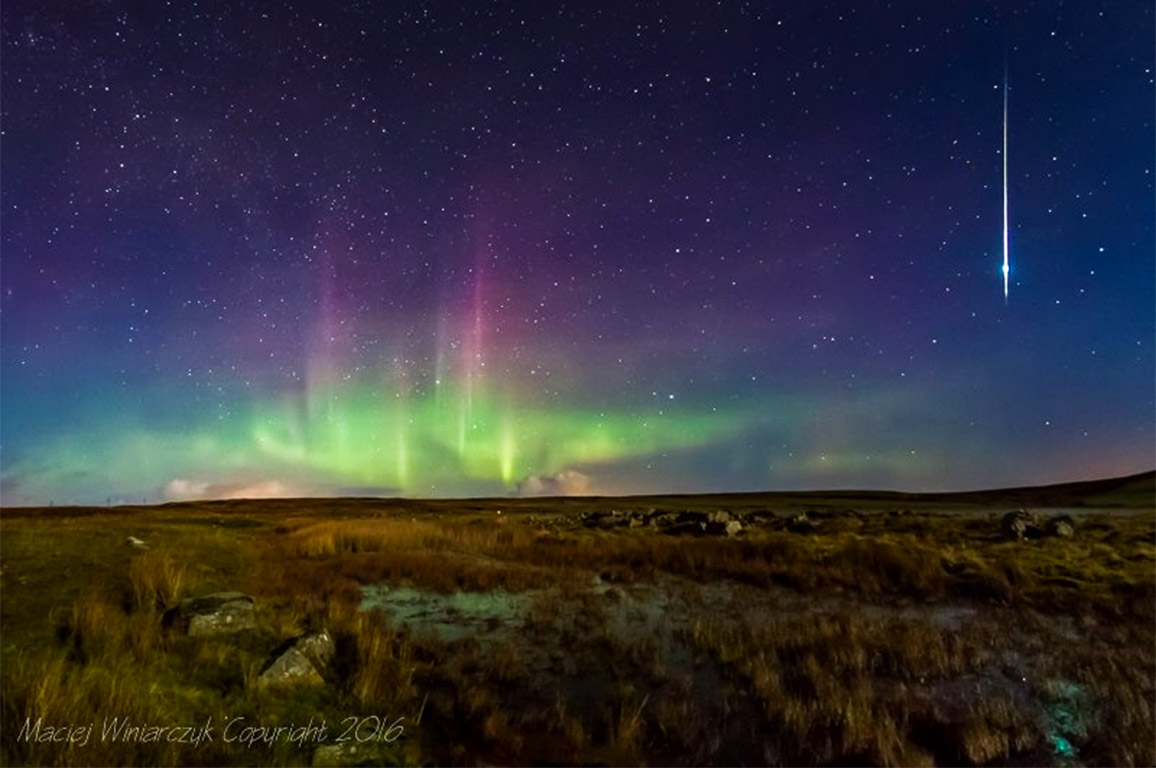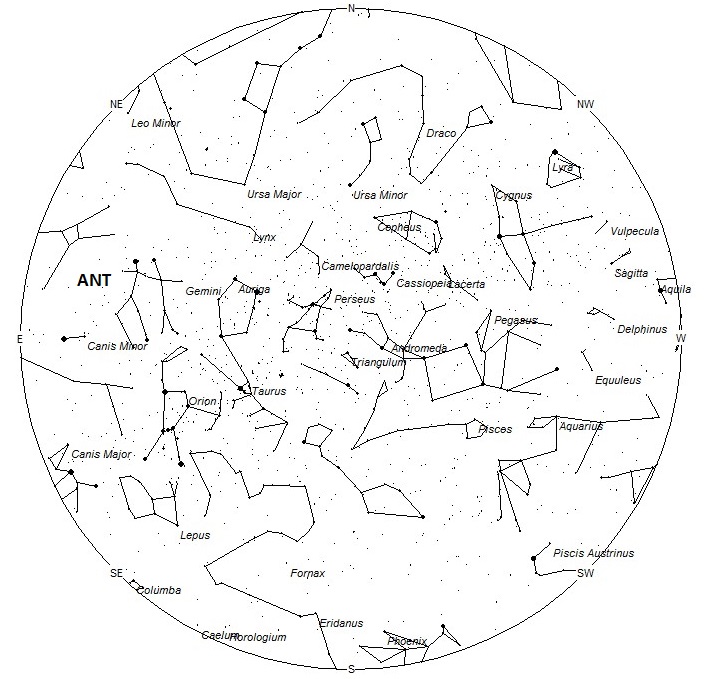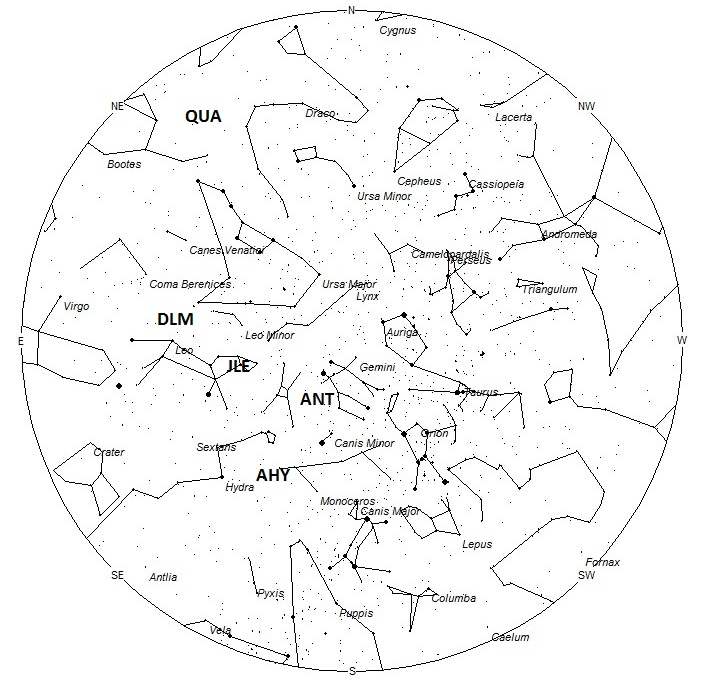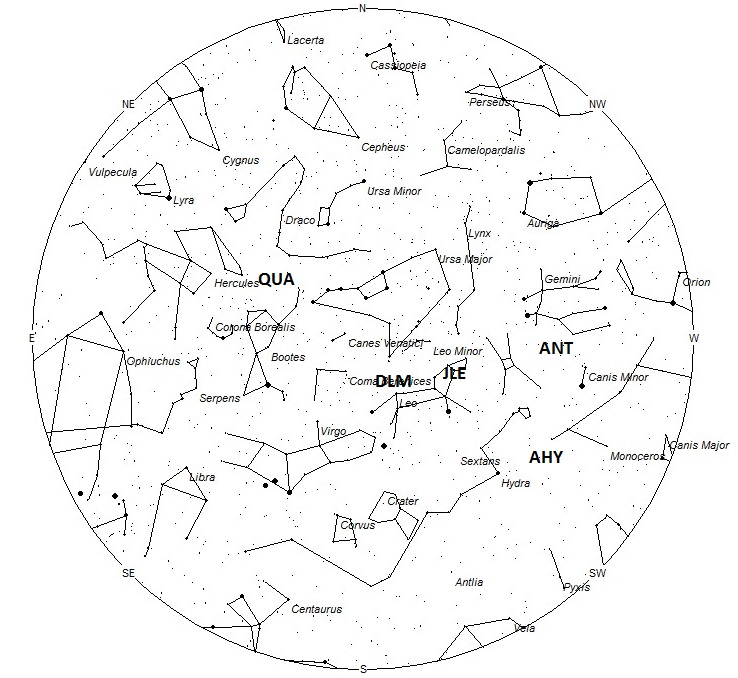
During this period the moon reaches its last quarter phase on Saturday January 2nd. On that date the moon will be located 90 degrees west of the sun and will rise near midnight as seen from mid-northern latitudes of North America. As the week progresses the waning crescent moon will be less of a problem with each passing night. The estimated total hourly meteor rates for evening observers this week is near 3 as seen from mid-northern latitudes (45N) and 2 as seen from tropical southern locations (25S). For morning observers the estimated total hourly rates should be near 16 as seen from mid-northern latitudes (45N) and 8 as seen from tropical southern locations (25S). Morning rates are slightly reduced during this period due to interfering moonlight. The actual rates will also depend on factors such as personal light and motion perception, local weather conditions, alertness and experience in watching meteor activity. Note that the hourly rates listed below are estimates as viewed from dark sky sites away from urban light sources. Observers viewing from urban areas will see less activity as only the brightest meteors will be visible from such locations.
The radiant (the area of the sky where meteors appear to shoot from) positions and rates listed below are exact for Saturday night/Sunday morning January 2/3. These positions do not change greatly day to day so the listed coordinates may be used during this entire period. Most star atlases (available at science stores and planetariums) will provide maps with grid lines of the celestial coordinates so that you may find out exactly where these positions are located in the sky. A planisphere or computer planetarium program is also useful in showing the sky at any time of night on any date of the year. Activity from each radiant is best seen when it is positioned highest in the sky, either due north or south along the meridian, depending on your latitude. It must be remembered that meteor activity is rarely seen at the radiant position. Rather they shoot outwards from the radiant so it is best to center your field of view so that the radiant lies at the edge and not the center. Viewing there will allow you to easily trace the path of each meteor back to the radiant (if it is a shower member) or in another direction if it is a sporadic. Meteor activity is not seen from radiants that are located below the horizon. The positions below are listed in a west to east manner in order of right ascension (celestial longitude). The positions listed first are located further west therefore are accessible earlier in the night while those listed further down the list rise later in the night.
These sources of meteoric activity are expected to be active this week.
The center of the large Anthelion (ANT) radiant is currently located at 07:40 (115) +20. This position lies in eastern Gemini, 8 degrees south of the 1st magnitude star known as Pollux (Beta Geminorum). Due to the large size of this radiant, Anthelion activity may also appear from western Cancer, and Canis Minor as well as Gemini. This radiant is best placed near 0100 local standard time (LST), when it lies on the meridian and is located highest in the sky. Rates at this time should be near 2 per hour as seen from the northern hemisphere and 1 per hour from south of the equator. With an entry velocity of 30 km/sec., the average Anthelion meteor would be of slow velocity.
The Alpha Hydrids (AHY) were discovered by Dr. Peter Brown and are mentioned in his article “A meteoroid stream survey using the Canadian Meteor Orbit Radar”. This shower is active from December 22 through January 7 with maximum activity occurring on December 31. The radiant is currently located at 08:32 (128) -08. This position lies in southwestern Hydra, 12 degrees west of the 2nd magnitude star known as Alphard (Alpha Hydrae). These meteors are best seen near 0200 LST when the radiant lies highest above the horizon. At 43 km/sec. the Alpha Hydrids produce meteors of medium velocity. Expected rates this week are less than 1 per hour no matter your location.
The January Leonids (JLE) were also discovered by Dr. Peter Brown and are mentioned in the same source as the Alpha Hydrids. This shower is active from December 30 through January 5 with maximum activity occurring on January 1st. The radiant is currently located at 09:52 (148) +24. This position lies in northwestern Leo, just a degree east of the 3rd magnitude star known as Ras Elased (Epsilon Leonis). These meteors are best seen near 0300 LST when the radiant lies highest above the horizon. At 59 km/sec. the Alpha Hydrids produce meteors of swift velocity. Expected rates this week are less than 1 per hour no matter your location.
The December Leonis Minorids (DLM) are a shower of long duration active from December 6th through January 18th. Maximum occurred near December 21st when rates may have reached 3 an hour. The radiant is currently located at 11:36 (174) +24. This position lies in northeastern Leo, 6 degrees northeast of the 3rd magnitude star known as Zosma (Delta Leonis). These meteors are best seen near 0400 LST when the radiant lies highest above the horizon. At 63 km/sec. the December Leonis Minorids produce mostly swift meteors. These meteors are visible from the southern tropics but not well seen from the deep southern hemisphere.
The Quadrantids (QUA) are active from December 30th through January 12th. Maximum occurs on January 4 when rates may have reached 100 an hour from dark sky locations over North America. The radiant is currently located at 15:16 (229) +50. This position lies in northern Bootes in a blank area of sky located directly between the stars known as Iota Draconis and Beta Bootis. These meteors are best seen during the last hour before dawn when the radiant lies highest above the horizon in a dark sky. At 41 km/sec. the Quadrantids produce meteors of moderate velocity. These meteors are visible from the southern tropics but not seen from the deep southern hemisphere. Rates on Sunday morning should be near 5 per hour increasing greatly toward maximum the next morning.
As seen from the mid-northern hemisphere (45N) one would expect to see approximately 8 sporadic meteors per hour during the last hour before dawn as seen from rural observing sites. Evening rates would be near 2 per hour. As seen from the tropical southern latitudes (25S), morning rates would be near 6 per hour as seen from rural observing sites and 2 per hour during the evening hours. Locations between these two extremes would see activity between the listed figures. Rates during the morning hours are reduced due to interfering moonlight.
| SHOWER | DATE OF MAXIMUM ACTIVITY | CELESTIAL POSITION | ENTRY VELOCITY | CULMINATION | HOURLY RATE | CLASS |
|---|---|---|---|---|---|---|
| RA (RA in Deg.) DEC | Km/Sec | Local Standard Time | North-South | |||
| Anthelions (ANT) | – | 07:40 (115) +20 | 30 | 01:00 | 2 – 1 | II |
| Alpha Hydrids (AHY) | Dec 31 | 08:32 (128) -08 | 43 | 02:00 | <1 – <1 | IV |
| January Leonids (JLE) | Jan 01 | 09:52 (148) +24 | 59 | 03:00 | <1 – <1 | IV |
| Dec. Leonis Minorids (DLM) | Dec 31 | 11:36 (174) +24 | 64 | 04:00 | 1 – <1 | II |
| Quadrantids (QUA) | Jan 04 | 15:16 (229) +50 | 41 | 08:00 | 5 – 1 | I |
 American Meteor Society
American Meteor Society



Tonight I saw a large comet / meteor in western Monmouth county New Jersey USA
On my morning drive to work down the southbound 405 freeway in Los Angeles, for the past several weeks I have been seeing bright streaks of light in the Eastern to East/Northeastern sky. These are NOT airline contrails, which have a completely different appearance, and continue to elongate, as they extend for a time and then stop. The local time for these to be appearing is ~6:10am to 6:30am, just before sunrise, PST.
Can anyone here confirm that these are meteors? I have searched the Web and listened to local news for some report on this, and have found nothing. I counted six (6) of these this morning, with that last and brightest one appearing quite high in the sky.
Thanks,
Eric
Eric and All,
These streaks do not sound like meteors. Meteors are totally random and do not appear in the same area of the sky morning after morning. Since you insist that these are not contrails, I cannot speculate as to what they may be.
Robert Lunsford